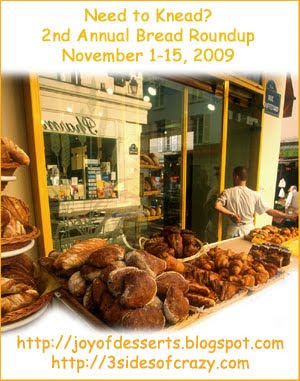
When participating, please use common blog etiquette and courtesy by linking your participating bread recipes back to
Joy of Desserts and
3 Sides of Crazy, and visiting the other participants.
TIPS for GREAT Bread Making
- Always keep flours in airtight, moisture proof containers.
- Once cooled, always store breads in airtight bags in a cool dry place.
- When freezing bread, always cool first and do NOT frost or decorate. Wrap them first in airtight plastic and then foil. Store no more than 3 months.
- To warm breads, wrap bread in foil. Place in 350 degree oven for 15-20 minutes.
- Dark flours such as rye ore whole wheat have less strength and should be mixed with bread flour for better results.
- Always cool breads fully before slicing. For best results use a serrated knife or electric knife for even slices.
- Kneading is a very important part of the bread making process. Kneading develops the protein structure which in turn produces higher volumes.
- Flavor and texture improve by allowing the dough to double in the size. Be patient.
- Allowing the dough to “REST” for 15 minutes also helps to achieve the desired volume.
- The true test for doneness is when the loaf sounds hollow!
- Remove from pans immediately and cool on wire racks to prevent them from becoming soggy.
ADOBE BREAD A Native American bread made by the pueblo-dwelling Indians of the Southwest and baked in the adobe ovens common to their dwellings. The bread’s made from unbleached flour, salt, yeast, water, lard or shortening and sometimes sugar and/or eggs. A hot fire is started in the adobe oven and allowed to burn out. The ashes are immediately removed and the bread is then baked. This crusty bread of the Pueblo Indians is still baked today in beehive shaped ovens. The round loaves are often decorated with symbols for special occasions.
2 cups whole wheat flour, medium grind
1/4 cup fine white sugar
1 tablespoon instant yeast
1/4 cup vegetable shortening or vegetable oil
2 cups warm water, 100-110 degrees
3 – 4 cups unbleached bread flour (preferred) or all-purpose flour
2 teaspoons salt (fine sea salt preferred)
MIXER METHOD:
- In a large mixing bowl, place whole wheat flour, sugar, dough enhancer if using, yeast and shortening; use the paddle attachment to mix on low speed until well-combined.
- Add warm water and beat for 1 minute or so.
- Stir in 3 cups of bread flour and mix on low speed until the dough forms a soft ball.
- Change to the dough hook and knead on medium speed about 5 minutes, adding only enough additional bread flour to make a manageable dough. The dough should have pulled away from the sides of the bowl but can still stick to the bottom of the bowl.
- Turn the dough out onto a floured board let it rest 10 minutes, covered with a towel.
- Knead the dough an additional 4-5 minutes or until the dough is soft and pliable, tacky but not sticky.
- Place in lightly greased bowl, cover with plastic wrap and let rise at room temperature (72 deg.F.) 45-60 minutes or until doubled in bulk.
- Spray a large baking sheet with PURE and set aside. Gently deflate the dough and turn out onto a lightly floured board.
- Divide in half and let rest 5 minutes.
- Shape each half into a round, stretching the dough across the top and tucking under; place the rounds on opposite wnsa of the cookie sheet.
- Cover and let rise in a warm place 40-50 minutes or until almost doubled.
- Meanwhile, preheat oven to 375 F. Using a lame or sharp knnife, make 1/2 inch deep slashes across each loaf (in lattice design if desired).
- Sprinkle each loaf lightly with bread flour. Bake 35-40 minutes until loaves are deep, golden brown and register 200 degrees on an instant thermometer.
- Remove from the pan and cool completely on a wire rack before slicing. Yields 2 loaves
MANUAL METHOD:
Follow the above instructions, kneading the dough by hand about 10-12 minutes.
NOTE~this is best made using a stand mixer!
APPLESAUCE RAISIN BREAD
2 cups applesauce
2 JUMBO eggs, beaten
1 cup fine sugar
1/2 cup butter, melted
4 cups flour
4 teaspoons baking powder
1 teaspoon salt
1 teaspoon baking soda
2 teaspoon cinnamon
2 teaspoon nutmeg
1 cup golden raisins
1/4 cup golden rum
1 cup minced walnuts
- In a large bowl, beat together the applesauce, eggs, sugar and melted butter.
- In a smaller bowl, sift together the dry ingredients.
- Stir the dry ingredients into the applesauce mixture and mix only until smooth.
- Add the raisins and nuts.
- Pour into 2 greased 9x5x3-inch loaf pans and bake in a 350 degree oven for 50 minutes or until a wooden toothpick inserted into centers comes out clean.
BUTTER HORN ROLLS
1 cup scalded milk, cooled
1 package yeast, dissolved in 1/8 cup warm water
1/2 cup unsalted butter, softened
1/2 cup sugar
1 teaspoon salt
3 eggs, beaten
4 1/2 cups flour
- Add yeast mixture to cooled scalded milk.
- Combine butter, sugar and salt with electric mixer on low.
- Add milk and yeast to butter mixture.
- Add beaten eggs.
- Add half of flour and increase speed to medium. Beat well for two minutes.
- Stir in remaining flour by hand to form a very soft dough.
- Let rise till double – about 3 hours.
- Divide into 3 equal parts. Roll each portion on lightly floured board to 9 -10 inch circle.
- Brush with butter.
- Cut each circle into 12 wedges (like a pizza).
- Roll from wide end (similar to a crescent roll) and place on cookie sheet.
- Let rise in a warm place for an hour before baking.
- Bake at 400 for 10 minutes.
- Makes 3 dozen
BUTTERMILK CORNBREAD
1 cup yellow cornmeal
1/3 cup all-purpose flour
1/4 teaspoon baking soda
1 teaspoon baking powder
1 teaspoon salt 1 egg, beaten
1 cup buttermilk
- Sift together dry ingredients.
- Add egg and buttermilk, mixing well.
- Pour into greased, heated 8-inch or 9-inch iron skillet.
- Bake at 400° for 20 minutes, or until lightly browned.
CHOCOLATE WALNUT BREAD CAKE
CAKE
2 cups flour
1/2 cup sugar
Pinch of salt
1 teaspoon cinnamon
2 tablespoons butter, softened
2/3 ounce fresh yeast
1/3 cup milk
1/2 cup heavy cream
1 egg
FILLING
1 cup + heavy cream
12 squares Baker’s semi-sweet chocolate, finely chopped
1/3 cup walnuts, minced
6 tablespoons butter, melted & cooled
- Sift the flour into a large mixing bowl.
- Add the sugar, cinnamon, salt, butter, yeast, milk, cream and egg. Using the hook attachment blend for 5 minutes – this can be done manually if you prefer. After 5 minutes the dough will be ready, so flour your hands to avoid sticking.
- Knead and allow to rise.
- On a floured surface, knead the dough and transfer to a bowl.
- Cover the bowl with a four sack towel and allow to rise for 2 hours in a warm place.
- In a saucepan heat the cream over medium heat bringing it to a slow boil. Remove from heat.
- Pour the hot cream over the chopped chocolate and mix together.
- Add the butter and whip with the spoon.
- Stir in walnuts and allow to cool.
- Press down on the dough and transfer to a floured surface. With a rolling pin, flatten the dough into a round about half an inch thick.
- Pour the chocolate sauce over the dough and spread evenly with the rubber spatula.
- Using a large knife, cut the dough into thick slices approximately 2 1/2 inches wide.
- Roll slices cinnamon roll style.
- Transfer the slices to a spring form pan with the edges very slightly touching.
- Allow to sit for 15 minutes before baking.
- Preheat the oven 350 degrees.
- Brush the top of the cake with butter and bake 15-20 minutes.
- Remove the cake from the oven, brush once more with butter and sprinkle with powdered sugar.
HONEY NUT BRAN MUFFINS
1/2 cup honey
1 1/2 cups flour
1/2 teaspoon baking soda
1/2 teaspoon salt
1 1/2 cups bran
2 tablespoons butter, melted
1 1/4 cups buttermilk
1 teaspoon maple extract
1 teaspoon vanilla extract
1 tablespoon molasses
1 teaspoon pumpkin pie spice
1 egg, beaten
1/4 cup walnuts, finely chopped
- Sift together flour, soda and salt. Combine with the bran.
- Add remaining ingredients, mixing just until well blended.
- Pour batter into greased and lightly floured muffin pans and bake at 425° for 25-30 minutes or until done in center.
ORANGE OATMEAL MUFFINS
1 cup flour
1 tablespoon baking powder
1/2 teaspoon salt
1 cup quick-cooking oats
1/4 cup sugar + 2 tablespoons sugar
1 JUMBO egg, beaten
1 tablespoon grated orange rind
1/2 cup fresh orange juice with high pulp
1/4 cup 2% milk
2 tablespoons vegetable oil
1/2 teaspoon grated orange rind
PURE
- Combine the flour, baking powder, salt, oats, and 1/4 cup sugar in a large bowl. Make a well in center of the flour mixture.
- Stir together egg, 1 tablespoon grated orange rind, orange juice, milk and oil.
- Add to flour mixture, stirring just until moistened.
- Spray muffin tins with PURE or line with papers.
- Spoon batter into muffin pans , filling three-fourths full.
- Stir together 2 tablespoons sugar, orange rind, and ground cinnamon until blended.
- Sprinkle evenly over tops of muffins.
- Bake at 400 for 15 minutes or until muffins are lightly browned.
- Remove muffins from pans immediately, and cool on a wire rack.
PARMESAN CHEESE BREAD
3 1/4 cups unbleached flour
1 tablespoon active dry yeast
2 teaspoons sea salt
1 1/3 cup warm water
1/2 cup freshly grated Asiago Parmesan Cheese
extra-extra virgin olive oil
- Sift together the four, yeast and salt.
- Stir in the water until dough forms.
- Sprinkle with 1/2 the cheese.
- Transfer to a well floured surface.
- Knead until soft, elastic and no longer sticky (about 10 minutes). Add flour as necessary to reduce stickiness.
- Knead the dough until it remains rounded and doesn’t flatten out when left to sit for a few minutes.
- Arrange into a round.
- Brush the surface with olive oil.
- Cover loosely with a tea towel and let rise in a warm place until double in size (about 2 hours).
- Preheat oven to 425 degrees.
- Brush a 9 inch round pan with olive oil.
- Put remaining cheese on a plate.
- Punch down the dough and knead a few more times with fresh flour.
- Divide dough into 12 pieces.
- Roll each piece into a ball.
- Roll each ball in the cheese and then place in pan with the edges touching. 9 balls around the outside, 3 balls in the center.
- Cover with a flour sack towel and allow to rise again.
- Cut a small slash in the top of each ball.
- Sprinkle with more Parmesan cheese.
- Bake for 10 minutes and the reduce oven temperature to 375 degrees and continue to bake until golden and crispy, about 20-30 minutes more.
- Serve hot or transfer to a wire rack and cool.
POLENTA BREAD
Polenta is made with ground yellow or white cornmeal and was originally made with Chestnut meal in ancient times. As it is known today, polenta derives from earlier forms of grain mush (known as puls or pulmentum in Latin or more commonly as gruel or porridge) commonly eaten in Roman times and after.
3 cups unbleached bread flour
1/2 cup finely ground polenta
2 teaspoons quick rise yeast
1 teaspoon sea salt
1 1/3 cups warm water
1 tablespoon extra-extra virgin olive oil
1 Jumbo egg, beaten
- In a large bowl sift together the flour, polenta, yeast and salt.
- Stir in the water and olive oil until dough forms.
- Transfer to a well floured surface.
- Knead until soft, elastic and no longer sticky (about 10 minutes). Add flour as necessary to reduce stickiness.
- Knead the dough until it remains rounded and doesn’t flatten out when left to sit for a few minutes.
- Arrange into a round.
- Cover loosely with a tea towel and let rise in a warm place until double in size (about an hour).
- Preheat oven to 425 degrees.
- When dough has risen, use a VERY sharp knife and slash the center of the loaf.
- Brush the surface with the beaten egg.
- Sprinkle cornmeal on the baking sheet and then transfer the loaf on top.
- Bake for 15 minutes and the reduce oven temperature to 375 degrees and continue to bake until golden and crispy, about 30-35 minutes more.
- Transfer to a wire rack and cool.
SOURDOUGH STARTER & BREADThe novel thing about sourdough baking is that it requires that you keep something alive in your fridge. Think of your starter as a pet that needs to be fed. Sourdough “starter” is a batter of flour and water, filled with living yeast and bacteria. The yeast and bacteria form a stable symbiotic relationship, and as long as you keep the starter fed can live for centuries, a thriving colony of microorganisms. To make sourdough bread, you blend the starter with some flour and make dough. The yeast propogates, and leavens your bread. This is how you make your starter:
- Select a container that your starter will live in. A wide-mouthed glass jar is best. A small crock with a loose lid is also great. You can also use a rubbermaid or tupperware container. Metallic containers are a bad idea; some of them are reactive and can ruin your starter (for the same reason, avoid using metal utensils to stir your starter).
- Blend a cup of warm water and a cup of plain unbleached flour, and pour it into the jar. That’s the whole recipe! If you want, you can add a little commercial yeast to a starter to “boost” it. Note that starter made with commercial yeast often produces a bread with less distinctive sour flavor than the real thing.
- Every 24 Hours, Feed the Starter. You should keep the starter in a warm place; 70-80 degrees Farenheit is perfect. This allows the yeast already present in the flour (and in the air) to grow rapidly. Temperatures hotter than 100 degrees or so will kill it.
- The way you feed the starter is to (1) throw away half of it and then (2) add a half-cup of flour and a half-cup of water. Do this every 24 hours. Within three or four days (it can take longer, a week or more, and it can happen more quickly) you should start getting lots of bubbles throughought, and a pleasant sour or beery smell. The starter may start to puff up, too. This is good. Here’s the gist: When your starter develops a bubbly froth, it is done.
- Refrigerate the Starter. Keep the starter in your fridge, with a lid on it. Allow a little breathing space in the lid. Once the starter is chilled, it needs to be fed only once a week. Realistically, you can get away with less; it’s important to remember that your starter is a colony of life-forms that are almost impossible to kill (except with extreme heat). Even starving them is difficult.
- Aside from weekly feeding, the only other thing you need to worry about is hooch. Hooch is a layer of watery liquid (often dark) that contains alchohol. It smells a bit like beer, because it is a bit like beer – but don’t drink it! Hooch builds up in your starter, especially in the fridge. Just pour it off or stir it back in. It doesn’t hurt anything. If your starter is looking dry, stir it back in. If your starter is plenty wet, pour it off. Just remember that hooch is nothing to worry about!
- Several hours before you plan to make your dough (recipe below), you need to make a sponge. A “sponge” is just another word for a bowl of warm, fermented batter. This is how you make your sponge.
- Take your starter out of the fridge. Pour it into a large glass or plastic bowl. Meanwhile, wash the jar and dry it.
- Add a cup of warm water and a cup of flour to the bowl. Stir well, and set it in a warm place for several hours. This is called “proofing,” another word for fermenting.
- Watch for Froth and Sniff. When your sponge is bubbly and has a white froth, and it smells a little sour, it is ready. The longer you let the sponge sit, the more sour flavor you will get. The proofing-time varies. Some starters can proof up to frothiness in an hour or two. Some take 6-8 hours, or even longer. Just experiment and see how long yours takes. If you’re going to bake in the morning, set your sponge out to proof overnight.
Of course, there are a lot of recipes for sourdough bread. There are also recipes for sourdough rolls, sourdough pancakes, sourdough pretzels, sourdough bagels…
You should have some leftover sponge and that is your starter for next time: Put it into the jar, and give it a fresh feed of a half-cup each of flour and warm water. Keep it in the fridge as above.
BASIC SOURDOUGH RECIPE
2 Cups of sponge (proofed starter)
3 Cups of unbleached flour
2 tablespoons softened butter
4 teaspoons of sugar
2 teaspoons of salt
- To the sponge, add the sugar, salt, and softened butter instead, or no oil at all). Mix well, then knead in the flour a half-cup at a time. Knead in enough flour to make a good, flexible bread dough. You can do this with an electric mixer, a bread machine on “dough cycle,” or a food processor. You can also do it with a big bowl and your bare hands. Keep in mind that flour amounts are approximate; flour varies in absorbency, and your sponge can vary in wetness. Use your judgement; treat it like ordinary white or french bread dough. Trust your hands and eyes more than the recipe, always.
- Let the dough rise in a warm place, in a bowl covered loosely with a flour sack towel . Note that sourdough rises more slowly than most yeast bread. Let the dough double in bulk. When a finger poked into the top of the dough creates a pit that doesn’t spring back), you’ve got a risen dough.
- Punch the dough down and knead it a little more. Make a loaf and place it on a baking sheet (lightly greased or sprinkled with cornmeal). Slit the top if you like, and cover the loaf with a paper towel and place it in a warm place to rise again, until doubled in bulk.
- Place the pan with the loaf in your oven, and then turn your oven to 350 degrees and bake the bread for 30-45 minutes. Do not preheat the oven. The loaf is done when the crust is brown and the bottom sounds hollow when thumped with a wooden spoon. Turn the loaf out onto a cooling rack or a towel and let it cool for an hour before slicing.
SOURDOUGH TOMATO CHEESE BREAD
1 1/2 cups sourdough starter
1 cup warm water (110 degrees F)
1 (.25 ounce) package active dry yeast
1 cup warm tomato juice
2 teaspoons white sugar
1 teaspoon salt
7 cups all-purpose flour
2 cups grated Sargento sharp cheddar cheese
- Dissolve yeast in 1 cup warm water, set aside.
- In large bowl; mix starter and tomato juice. Add yeast mixture, salt, sugar and stir well.
- Add 1 cup of flour at a time and beat well to develop the gluten.
- Add cheese just until well blended.
- When a stiff dough forms, turn out onto a floured surface and knead until smooth and elastic, adding the last 1 cup of flour as you go.
- Turn into greased bowl and lightly grease top, cover with towel and place in draft free area for 2 hours. Will double in bulk.
- Punch down and divide dough in two, form into rounds and place each on a baking sheet that has been sprinkled generously with cornmeal.
- Let rise 1/2 hour, rub top lightly with flour and slash with sharp knife. Bake at 350 degrees F for 45-60 minutes or until bottoms are lightly browned.
- For a soft crust, cool under a clean flour sack dishtowel. For a harder European type crust, cool without.
♥♥ ♥♥
♥♥






















